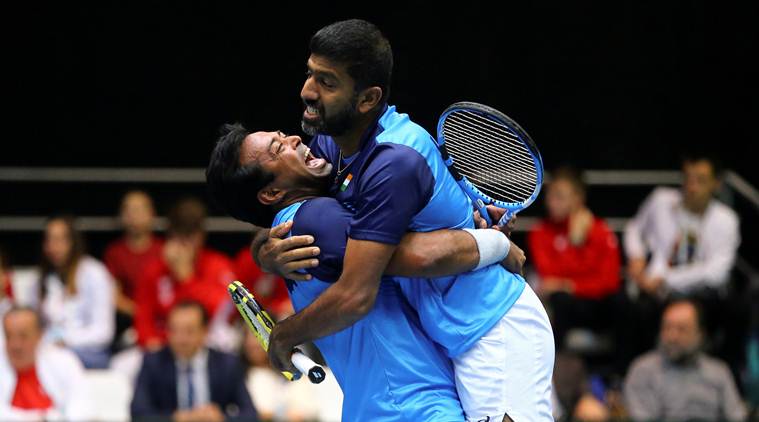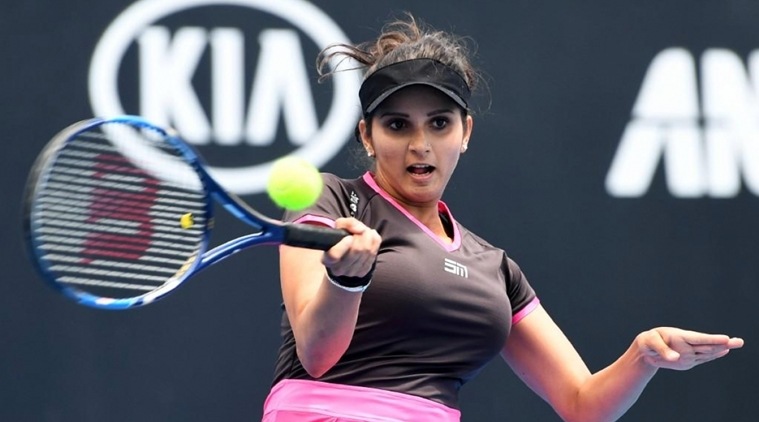 Leander Paes and Rohan Bopanna. (Source: Reuters)
Leander Paes and Rohan Bopanna. (Source: Reuters)
A world under lockdown has prompted virtual brainstorming sessions in every field, and Indian tennis is no different.
A fortnight-long ‘webinar’ for coaches, trainers, and nutritionists, organised by Sports Authority of India and All India Tennis Association, concluded on Saturday. Among the topics discussed during the two-hour video chats were transition to the senior level, tournament structure, and training methods.
Among the participants were the country’s top tennis players, as Grand Slam champions Leander Paes, Sania Mirza, and Rohan Bopanna broke down their techniques and processes in candid interviews.
Leander’s Nintendo reflexes
During his session, Paes offered glimpses into what goes into a three-decade-long career: from the 5,000 daily rope skips, weather chat with taxi drivers to lentils, potatoes, and bananas.
And then came Pac-Man — the 80s arcade video game featuring the beloved yellow overeater and his annoying nemeses, and the quirkiest ingredient behind Paes’ lightning hands.
“When I was about 8, 9 years old, I thought (Vece Paes, hockey Olympian) was the coolest dad in the world because he used to give me a hundred rupees a day to play video games,” Paes, who turns 47 next month, said. “A bit of misspent youth. But every single day, I had to spend 100 rupees at the Sub-Zero video game parlour on Park Street, right opposite my house (in Kolkata). Pac-Man was like the most important game back then. Space Invaders was very popular. I thought it was very cool, and then I realised the trick that he was doing.”
“By working that joystick with my right hand, and watching the screen go down… that was the very first digital technology that had come around. Nowadays, you have some very sophisticated technology to train your eyes because that is one of the most important things in sports today. When you see something, then only can your brain click in. Then the rest of your muscle memory comes in and your body reacts. Digital technology is the reason that my hands are so fast.”
Sania’s hyper-forehand
 Sania Mirza has won six Grand Slams in her career. (Source: File Photo)
Sania Mirza has won six Grand Slams in her career. (Source: File Photo)
Bob Brett, who has coached Boris Becker and Goran Ivanisevic, helped build up her backhand. But Sania only needs to glance at photographs from her early playing days to decipher the origins of the forehand.
“Photos from when I was 7, 8. The forehand is exactly the same as today. It’s just natural ability. I can’t name anyone who taught me that,” Sania shared with the viewers. “I think every coach in India knows what I’m about to say. I had an extreme western grip, the back of my wrist would face the net. By the time I was 11, 12, they started changing my grip a little bit. But after a point, I refused to change it at all. Everyone said, ‘you will face wrist issues’. I said I wouldn’t know how to play a forehand if I don’t hold a racquet like this’. It’s natural because of my hypermobile joints.”
That her joints moved beyond the normal range of motion made her prone to injuries, but the flexibility also helped her crack the wristy stroke.
“Because of that, I am able to change the direction of the forehand at the very last moment. That always meant my opponents couldn’t read (it). Usually, you can change the direction of your forehand with your shoulder. Your left shoulder can point it out to your opponents, telling them where you’re going to hit the forehand. But I can be in any position and still be able to change the direction. The forehand comes naturally to me.”
Timing, though, came with toil.
“I did a lot of work on my timing. I tried to take the ball as early as possible. Early contact increases the power of the strokes. If you go even a little bit backward, it takes away 10 miles from your pace.”
Rohan’s doubles fitness
 Rohan Bopanna’s only Grand Slam was in 2017 French Open mixed-doubles. (Source: File Photo)
Rohan Bopanna’s only Grand Slam was in 2017 French Open mixed-doubles. (Source: File Photo)
Bopanna recalled a practice session with his current doubles partner Canadian Denis Shapovalov, wondering “what was I doing with guys half my age.”
“I was in Stuttgart last year, practising with Shapovalov, against Alex de Minaur and his partner. Denis moves on the court so well, I may break my ankle if I tried the same,” the 40-year-old said. “Travelling with a physio has prolonged my career. Learning how important a fitness trainer is and doing tennis-specific drills. That I don’t think, when I started as a junior, was even there. Unfortunately, we didn’t have access to these kinds of trainers. There were no video calls or WhatsApp calls.”
Bopanna also broke down the fitness requirements in doubles.
“A lot of doubles-specific movements are forward and backward, not so much lateral. Your transition is (about) going to the net. And staying low at the net, doing a lot of squats. Making sure your legs are strong because you are constantly playing in the ‘I formation’ or the ‘Aussie formation’. There are a lot of vertical jumps as well.”
“Today, even on the ATP Tour, a lot of players are playing doubles. Not only because it enhances their games but also with three players winning all the Grand Slams, rest are also taking a chance to do well at least in doubles,” said Bopanna. “But the fitness level is still very, very high. Just because you’re playing doubles and playing on the half-court and there is somebody there with you (, you can’t take it easy). You still work as much as somebody who plays singles.”